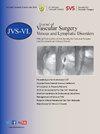下肢有纺和无纺静脉支架的形态和管腔变化。
IF 2.8
2区 医学
Q2 PERIPHERAL VASCULAR DISEASE
Journal of vascular surgery. Venous and lymphatic disorders
Pub Date : 2024-05-20
DOI:10.1016/j.jvsv.2024.101893
引用次数: 0
摘要
目的:静脉支架是治疗阻塞性静脉疾病的常用方法。静脉支架有编织结构和编织结构之分,有开放式和封闭式细胞排列之分,也有材料成分(埃吉洛伊和镍钛醇)之分。随着时间的推移,静脉支架形态的变化可能会导致再狭窄或血栓形成。与专用静脉支架相比,埃尔吉洛伊编织支架容易发生近端和远端边缘变形,而专用静脉支架可增加支架边缘的径向力。本研究的目的是描述各种静脉支架之间以及有纺与无纺静脉支架配置之间随着时间推移发生的管腔形态变化:方法:2014 年 1 月至 2021 年 6 月期间在一家医疗机构进行的回顾性研究确定了接受静脉支架治疗的患者。研究纳入了髂静脉和/或股静脉支架术中血管内超声(IVUS)和术后计算机断层扫描(CT)的患者。初次支架植入时,通过血管内超声(IVUS)测量每个支架的近端、中间和远端横截面直径,并与随访时通过 CT 成像测量的横截面直径进行比较。使用配对 t 检验比较管腔变化,并使用 D'Agostino-Pearson 检验进行正态性检验:结果:在38名患者中发现了54个支架。平均随访时间为 17.5 个月。支架分别植入髂总静脉(37个,68.5%)、髂外静脉(14个,25.9%)和股总静脉(3个,5.6%)。植入的支架包括波士顿科学 Wallstent(23 个,42.6%)、Bard Venovo(3 个,5.6%)、波士顿科学 Vici(23 个,42.6%)和美敦力 Abre(5 个,9.3%)。近端测量的平均管腔损失为 2.12 毫米(95% 置信区间 (CI),1.64-2.60;pConclusion):本研究报告了静脉支架内部以及有纺和无纺静脉支架之间的形态变化。我们的研究结果表明,传统上归因于编织结构的边缘支架管腔缩小也发生在新型无纺支架上。造成这种变化的可能还有其他因素,如解剖位置、骨盆弧度或其他外力,而不是支架的几何结构。本文章由计算机程序翻译,如有差异,请以英文原文为准。
Lower extremity woven and nonwoven venous stent morphology and luminal changes
Objective
Venous stents are a common treatment modality for obstructive venous disease. Venous stents differentiate themselves by either a woven or braided structure, open or closed cell arrangement or based on material composition (elgiloy vs nitinol). Changes in the morphology of venous stents over time may contribute to restenosis or thrombosis. Woven elgiloy stents are prone to proximal and distal edge deformation compared with dedicated venous stents, which offer increased radial force at stent edges. The objective of this study is to describe luminal morphological changes among various venous stents and between woven to nonwoven venous stent configuration, over time.
Methods
A retrospective review at a single institution between January 2014 and June 2021 identified patients treated with venous stents. Patients with iliac and/or femoral venous stents with intraoperative intravascular ultrasound and a postoperative computed tomography scan were included in the study. Cross-sectional diameters measurements were taken at proximal, middle, and distal portions of each stent from intravascular ultrasound examination at the time of initial stenting and compared with the cross-sectional diameter measurements taken from computed tomography imaging at follow-up. A paired t test was used to compare the luminal change with a D'Agostino-Pearson test used for normality.
Results
Fifty-four stents distributed among 38 patients were identified. The mean time to follow-up was 17.5 months. Stents were placed in the common iliac vein (n = 37, 68.5%), external iliac vein (n = 14, 25.9%), and common femoral vein (n = 3, 5.6%). Implanted stents included the Boston Scientific Wallstent (n = 23, 42.6%), Bard Venovo (n = 3, 5.6%), Boston Scientific Vici (n = 23, 42.6%), and Medtronic Abre (n = 5, 9.3%). The mean luminal loss was measured at 2.12 mm proximally (95% confidence interval [CI], 1.64-2.60; P<.001), 1.29 mm at the mid-stent (95% CI, 0.83-1.74, P<.001), and 1.56 mm distally (95% CI, 0.99-2.12; P<.001). There was no significant difference in luminal changes between woven and nonwoven stents at proximal (P = .374), middle (P = .179), and distal (P = .609) stent measurements.
Conclusions
This study reports morphological changes within venous stents and between woven and nonwoven venous stents. Our findings demonstrate that the edge-stent luminal decrease traditionally attributed to woven configurations also occurs with the newer nonwoven stents. Additional factors such as anatomical location, pelvic curvature, and other external forces may be accountable for this change rather than geometrical configuration of the stent.
求助全文
通过发布文献求助,成功后即可免费获取论文全文。
去求助
来源期刊

Journal of vascular surgery. Venous and lymphatic disorders
SURGERYPERIPHERAL VASCULAR DISEASE&n-PERIPHERAL VASCULAR DISEASE
CiteScore
6.30
自引率
18.80%
发文量
328
审稿时长
71 days
期刊介绍:
Journal of Vascular Surgery: Venous and Lymphatic Disorders is one of a series of specialist journals launched by the Journal of Vascular Surgery. It aims to be the premier international Journal of medical, endovascular and surgical management of venous and lymphatic disorders. It publishes high quality clinical, research, case reports, techniques, and practice manuscripts related to all aspects of venous and lymphatic disorders, including malformations and wound care, with an emphasis on the practicing clinician. The journal seeks to provide novel and timely information to vascular surgeons, interventionalists, phlebologists, wound care specialists, and allied health professionals who treat patients presenting with vascular and lymphatic disorders. As the official publication of The Society for Vascular Surgery and the American Venous Forum, the Journal will publish, after peer review, selected papers presented at the annual meeting of these organizations and affiliated vascular societies, as well as original articles from members and non-members.
 求助内容:
求助内容: 应助结果提醒方式:
应助结果提醒方式:


